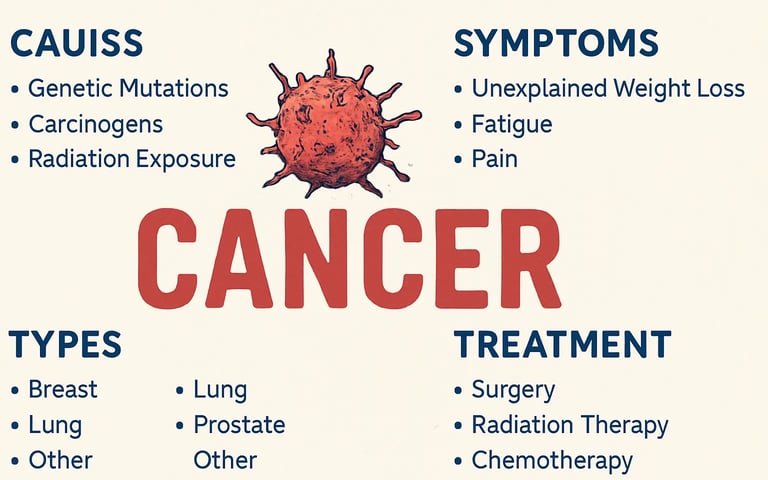What Is Cancer? Causes, Types, Symptoms, Diagnosis & Treatment
Learn what is cancer, its causes, symptoms, types, stages, and treatments. Discover prevention tips and the importance of early detection and research. #Cancer


Cancer is a broad term that refers to a group of diseases characterized by the uncontrolled growth and spread of abnormal cells in the body. These abnormal cells can form tumors or invade nearby tissues and organs. Cancer can occur in almost any part of the body.
What Is Cancer? Causes, Types, Symptoms, Diagnosis & Treatment
Cancer is a broad and complex group of diseases that occurs when abnormal cells in the body begin to grow and divide uncontrollably. These cancerous cells can form masses known as tumors, invade nearby tissues, and, in many cases, spread to other parts of the body—a process called metastasis. Unlike normal cells, which follow a structured life cycle of growth and death, cancer cells ignore these signals and continue multiplying, often leading to serious health complications.
Cancer can affect virtually any part of the body, and its impact depends on the type, location, stage, and how early it is detected and treated.
🔍 What Causes Cancer?
Cancer can be triggered by a variety of factors, either environmental, genetic, or lifestyle-related. Some of the most common causes include:
Genetic mutations (inherited or acquired)
Carcinogens such as tobacco smoke, asbestos, and certain industrial chemicals
Radiation exposure, including ultraviolet (UV) rays from the sun
Viral infections, like Human Papillomavirus (HPV), Hepatitis B and C, and Epstein-Barr virus
Poor lifestyle habits, such as smoking, heavy alcohol consumption, sedentary behavior, and unhealthy diets
📋 Common Types of Cancer
There are over 100 different types of cancer, usually classified by the tissue or organ where the disease starts. Some of the most common include:
Breast Cancer – Originates in the breast tissue, common in women but can also affect men.
Lung Cancer – Often linked to smoking, includes non-small cell and small cell types.
Prostate Cancer – Affects the prostate gland in men and is one of the most common male cancers.
Colorectal Cancer – Starts in the colon or rectum and typically begins as benign polyps.
Skin Cancer – Includes basal cell carcinoma, squamous cell carcinoma, and melanoma.
Leukemia – A cancer of the blood or bone marrow, often disrupting blood cell production.
Lymphoma – Affects the lymphatic system; includes Hodgkin and non-Hodgkin lymphoma.
Brain Cancer – Tumors in the brain or spinal cord, which can be life-threatening.
Ovarian Cancer – Found in the ovaries, often detected at later stages.
Pancreatic Cancer – Known for its aggressive nature and difficult early detection.
📈 Cancer Staging and Metastasis
Cancers are typically assigned a stage from 0 to 4, depending on how far the disease has spread:
Stage 0: Pre-cancer or in-situ
Stage 1-2: Localized cancer
Stage 3: Regional spread to nearby tissues
Stage 4: Advanced cancer with distant metastasis
Metastasis makes treatment more complicated and is a key factor in prognosis.
⚠️ Symptoms of Cancer
Symptoms vary widely depending on the type of cancer and the organs affected. However, common warning signs include:
Unexplained weight loss
Persistent fatigue or weakness
Lumps or swelling
Skin changes or unusual bleeding
Chronic cough or hoarseness
Changes in bowel or bladder habits
🩺 How Is Cancer Diagnosed?
Early detection plays a critical role in successful treatment. Diagnosis often involves:
Imaging tests: X-rays, CT scans, MRI, and PET scans
Blood tests: For tumor markers and overall health
Biopsies: Removing tissue samples for microscopic examination
Genetic testing: To identify inherited cancer risks
💊 Treatment Options for Cancer
Cancer treatment varies by type, stage, and overall health of the patient. Common methods include:
Surgery: Removing tumors or cancerous tissues
Chemotherapy: Using drugs to kill cancer cells
Radiation therapy: Destroying cancer cells with targeted radiation
Immunotherapy: Boosting the immune system to fight cancer
Targeted therapy: Attacking specific molecules involved in cancer growth
Hormone therapy: For cancers sensitive to hormones, like breast or prostate cancer
🛡️ Can Cancer Be Prevented?
While not all cancers can be prevented, you can reduce your risk through:
Avoiding tobacco and limiting alcohol
Eating a balanced, nutrient-rich diet
Regular exercise and maintaining a healthy weight
Using sunscreen and avoiding tanning beds
Getting vaccinated (e.g., HPV, Hepatitis B)
Routine cancer screenings (mammograms, colonoscopies, Pap smears)
🧪 The Role of Research and Innovation
Cancer research continues to evolve rapidly, bringing forward new breakthroughs in genetic therapies, precision medicine, liquid biopsies, and personalized treatment plans. Clinical trials are an essential part of this progress and offer new hope to patients with advanced or treatment-resistant cancers.
🧠 Final Thoughts
Cancer remains one of the most significant health challenges globally, but advancements in research, early detection, and modern treatments offer more hope than ever. Awareness, education, and proactive health management are key in the fight against cancer.
If you’re concerned about cancer risks, symptoms, or prevention, consult a healthcare professional for personalized guidance and screenings.
